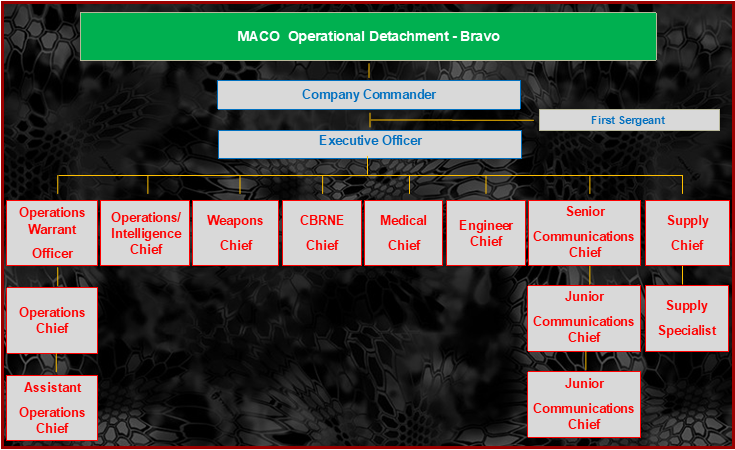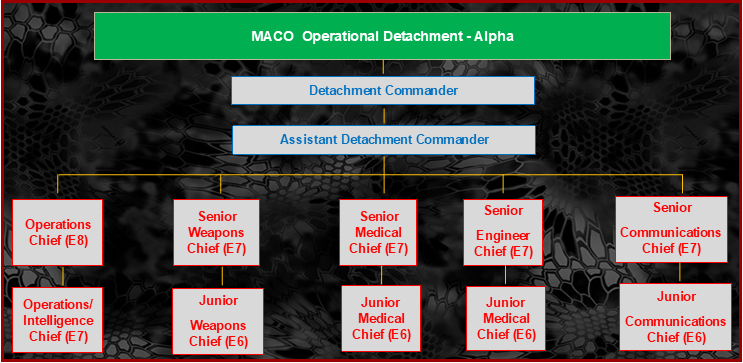


MACO Company (MCO)
The MCO is also referred to as a MACO Team which is a cohesive tactical sized unit that can perform a battlefield function on its own. This is the size/type of unit for the individual MACO unit within the current structure of the STF31 MACO.
A significant difference exists between most conventional Starfleet ground forces companies and MCOs. A MCO headquarters is a MODB, which is commanded by an experienced MACO Lieutenant Commander. The composition of a MCO, which is described in further detail below, enables the MCO to mission command its own organic or attached MODAs in garrison and when deployed. It also provides the MBN commander with an additional operational element that can conduct its own assigned mission. The mission may require the MODB to operate separately or exercise mission command of a mix of organic and/or attached MODAs.
Mission
The MCO plans and conducts special operations activities in any operational environment—permissive, uncertain, or hostile—and can deploy to conduct MACO operations in a specified area of operations or joint special operations area. In this capacity, the MODB can plan and conduct MACO operations either separately or as part of a larger force. The MODB can also provide operational support to either the MBN of an MGRP by establishing and operating a SOCCE or a MACO liaison element, an AOB, or an isolation facility.
Organization

MCO’s consist of a MODB and six MODAs. The MODB is a 16-man team. A typical MCO has one MODA trained in underwater operations and one MODA trained in military free-fall. The remaining MODAs may be trained in MACO military mountaineering, surface maritime operations (water infiltration and scout swimmer), or mobility operations based on each MODA mission-essential task list.
Function
In garrison, the MODB mission commands its own organic MODAs. When deployed, the MODB functions as a separate operational detachment with its own assigned mission. The mission may require the MODB to operate separately or to exercise operational control of a mix of organic and attached MODAs or other JSOTF assets. The MCO commander is an experienced MACO Lieutenant Commander.
Characteristics
The MCO has the capacity to—
· Train and prepare MODAs for deployment.
· Infiltrate and exfiltrate an operational area by air, land, and sea.
· Conduct operations in remote areas for extended periods with minimal external direction and support.
· Develop, organize, equip, train, and advise or direct indigenous forces of up to regimental size.
· Serve as a SOCCE or MACO liaison element at a functional component or Service component headquarters.
· Establish and operate an AOB to expand the command and control capabilities of the JSOTF or SOTF.
· Establish and operate an isolation facility for a JSOTF or SOTF.
Because the MODB is relatively small, it may require augmentation to perform functions such as serving as a SOCCE or MACO liaison element, or establishing and operating an AOB or isolation facility. The MODB is not designed to operate as a split element.
Crisis Response Force
The crisis response force is a regionally oriented force required to respond to a crisis and conduct contingency operations within its designated regional joint operations area. Each GCC has one MCO dedicated for this purpose. The crisis response force is under operational control of its regional GCC and under administrative control of its own organic MGRP.
All MACO personnel assigned to a crisis response force have prior experience on MODAs and are graduates of the MACO Advanced Reconnaissance, Target Analysis, and Exploitation Techniques Course. Select personnel within the crisis response force are also graduates of the MACO Sniper Course. Detachment commanders are senior captains who have previous detachment command experience and are selected by both battalion and group commanders for these positions. Assistant detachment commanders are veteran MACO warrant officers who have prior assistant detachment commander experience and prior experience in a crisis response force as a noncommissioned officer. These warrant officers are selected for these positions by their battalion and group senior warrant officers and battalion and group commanders. Detachment operations Chiefs are noncommissioned officers who have prior crisis response force experience. Crisis response force company commanders and company sergeants major are selected based on being MACO Advanced Reconnaissance, Target Analysis, and Exploitation Techniques Course graduates and having previous crisis response force experience.
MACO OPERATIONAL DETACHMENT—ALPHA

The MODA (also known as an ODA, A detachment, or A team) is composed of 12 men. It is the primary MACO operational unit and the building block for MACO operations. All other MACO organizations are designed to command, control, and support the MODA.
Mission
The MODA is designed to organize, equip, train, advise or direct, and support indigenous military or paramilitary forces engaged in UW or FID activities. Using its inherent capabilities, the MODA also performs the other MACO principal tasks. The time-tested composition of the MODA remains as viable and relevant today as it has been throughout the history of MACOs.
Organization
The Team Leader of a 12-man MODA is a Lieutenant. Other key leadership on a MODA are the Assistant Team Leader (a MACO Warrant Officer) and the operations Chief (a Senior Chief Petty Officer). The MODA has one intelligence Petty Officer 2nd Class and two Petty Officer 3rd Class’s in each of the four primary MACO functional areas—weapons, engineer, medical, and communications.
Just as conventional units task organize to perform specific missions, MACO Team Leaders also task organize in response to mission requirements. MACO Team Leaders can tailor a MODA when an integral MODA is not the optimal organization to perform a mission or when a mission requires a mix of skills not found in an integral MODA. There are two means of tailoring MODAs: split-team operations and composite teams.
Split-Team Operations
Split-team operations allow the MODA to be employed in numerous configurations. The redundant capabilities of the four primary MACO functional areas within an MODA allow the detachment Team Leader to employ his detachment in a split-team configuration, where a MODA is divided into two or more operational elements, each capable of conducting sustained operations on a reduced scale. A detachment Team Leader may opt for split-team operations when—
· The assigned mission or situation does not warrant the employment of the full team.
· The hostile situation does not permit operations by a complete MODA.
· A change in situation requires a deployed MODA to split and execute an additional mission.
The task organization for split-team operations are situational or mission dependent. In one example of a simple split-team operation, the detachment Team Leader and the assistant Team Leader each command one of the split teams. The Operations Chief and the second senior-ranking non-commissioned officer on the detachment serve as the senior non-commissioned officers on the split teams.
Composite Teams
Certain MACO missions require the organization of composite teams. A MACO Team Leader will usually reserve the right to tailor a composite team dependent upon the situation and mission. The MACO Team Leader will draw individual Operators from established MODAs to obtain the proper mix of skills and experience needed to conduct a specific mission. The MACO Team Leader must balance mission requirements against the effects on unit morale, readiness, and operations security before organizing composite teams. Additional MACO, SOF, or other personnel (other government agencies, conventional forces, or combined forces) may augment MODAs to form composite teams.
Function
MODAs can operate independently or with indigenous forces within a denied area. The MODA has many functions. Among these, the MODA can—
· Plan and conduct MACO operations separately or as part of a larger force.
· Infiltrate and exfiltrate specified operational areas by air, land, and sea.
· Conduct operations in remote or denied areas for extended periods of time with a minimum of external direction and support.
· Develop, organize, equip, train, and advise or direct indigenous forces up to battalion size.
· Train, advise, and assist other Federation and multinational forces and agencies.
· Plan and conduct unilateral MACO operations.
· Perform other special operations activities as directed by higher authority.
Characteristics
Cross-training is fundamental to MACO Operators. All team members conduct cross-training within the MODA in their various MACO Occupational Specialty skills. These additional skills are important in maintaining split-team operations and a mission-capable status in the event of a casualty.
To ensure functional coverage of all pre-mission activities, the MODA Team Leaders organizes a detachment staff using the mission variables—mission, enemy, terrain and weather, troops and support available, time available, and civil considerations. Detachment staff members perform their functional duties. Because of the limited number of personnel on an MODA, they are of limited use as a strike, long-term, or permanent occupation force. Certain missions may require augmentation from a SOTF, JSOTF, or conventional forces.
